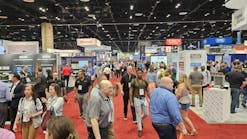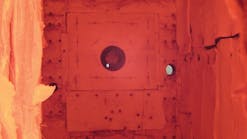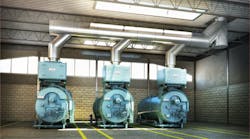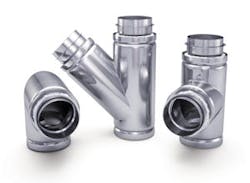Successful boiler operation is highly dependent on exhaust-system design and installation, as boiler inefficiency, burner shutdown, and flame-ignition failure upon startup can result from a poorly designed stack system.
Following are key considerations when selecting and installing a boiler stack:
• Boiler category. Boilers are divided into four categories (I, II, III, and IV) based on exhaust-stack pressure and temperature and the likelihood of condensate in the vent.
Stack designs for condensing boilers differ from those for near-condensing boilers.
Heat-exchange design, along with improved combustion technology, enable condensing boilers to recover heat from exhaust gases by condensing water vapor that otherwise would be lost up the flue.
With a near-condensing boiler, flue gases likely will condense in the stack. Designing a stack for these boilers can be complex, as they may fall into two or even three categories, depending on the way they are operated. Stack selection must take into account construction materials, the jurisdiction’s gas code, and the manufacturer’s recommendations. Stack selection is critical to ensuring optimum performance and long equipment life.
• Sizing. A vertical stack should be at least as tall as the breeching is long. If boilers are combined, airflow through the common breeching system should be the sum of the minimum flows of all of the boilers. The stack and breeching must provide the required draft at each boiler’s flue-gas outlet. Draft is critical to burner performance. Although constant pressure at flue-gas outlets is not always required, it is necessary to size the stack/breeching to limit flue-gas pressure variation. Consult the manufacturer for the range of allowable pressures.
• Amount of natural draft. Combustion flue gases inside of a chimney or stack can be much hotter and, thus, less dense than the ambient outside air. This variance causes the pressure at the bottom of the vertical column of hot flue gas to be lower than the pressure at the bottom of a corresponding column of outside air. The higher pressure outside of the chimney moves the required combustion air into the combustion zone and moves the flue gas up and out of the chimney. That movement, or flow of combustion air and flue gas, is called “natural draft.” The taller the stack, the greater the amount of draft that is created. There can be cases of diminishing returns; if a stack is disproportionately tall relative to the heat exiting the stack, the flue gases may cool down before reaching the top of the chimney. This condition can result in poor drafting. A number of variables must be evaluated for a chimney or stack to be designed with the right amount of natural draft.
• Ventilation. Buildings today are constructed to save energy. As a result, their ventilation systems can be very sophisticated and bring in less air than they vent out. This causes negative pressure in a building. To obtain balance, outside air follows the path of least resistance, which often is the stack, especially if it is not a sealed circuit.
• UL certification. UL certification ensures a stack system is safe and in compliance. All UL-listed systems have met certain testing requirements, which is particularly important if a stack system is near a combustible material.
• Materials of construction. Factors such as boiler temperature, chemicals released during combustion, condensation, corrosion, and wind influence material choices. For example, the condensate expelled from a condensing boiler is acidic. As a result, rust could become an issue. Selecting a stack system made up of the right materials, thus, is critical to ensuring optimal system performance and longevity.
Marc André Séguin is business-development manager for Cleaver-Brooks’ exhaust solutions. He has a bachelor’s degree in mechanical engineering from École de technologie supérieure (ÉTS) in Montreal. He has more than 10 years of technical sales experience in the mining, aerospace, and HVAC industries.
Did you find this article useful? Send comments and suggestions to Executive Editor Scott Arnold at [email protected].










